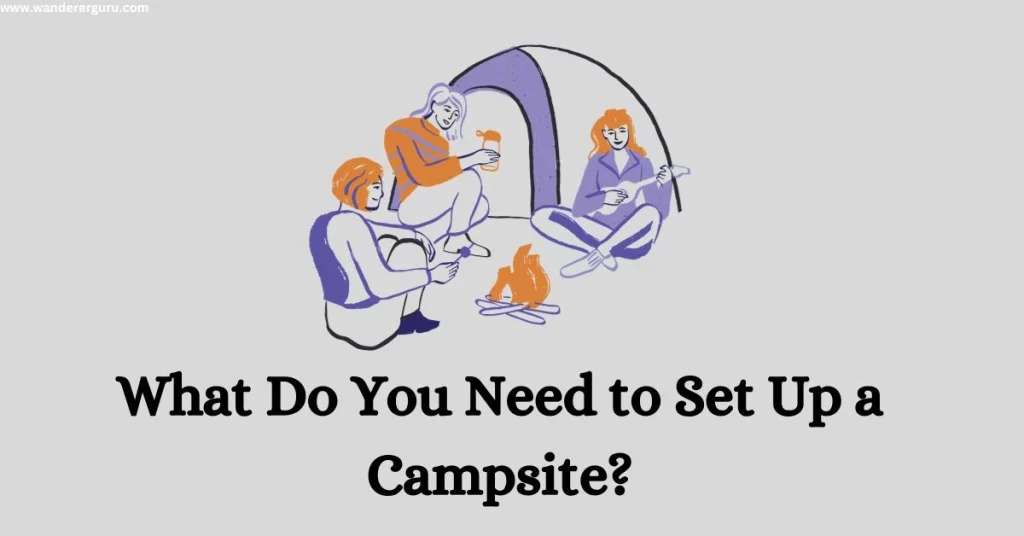Learning how to set up a campsite in the great outdoors is not just a practical skill; it’s your gateway to unforgettable adventures. Whether towering forests surround you, nestled in the heart of the mountains, or perched by a serene lakeside, your ability to establish a comfortable and efficient campsite can make or break your outdoor experience.
Bonus:
10 BEST WATERFRONT RV PARKS IN TEXAS, USA
How to set up a campsite?
Setting up a campsite involves selecting a level, well-drained area and gathering essential gear such as a tent, sleeping bags, cooking equipment, and personal items. Clear the debris site, assemble your tent, and organize your gear. This ensures a safe and comfortable outdoor experience, allowing you to enjoy nature while being well-prepared for your adventure.
Where Can I Set Up a Tent?
Research Local Regulations
First, you need to understand the regulations and rules in the area where you plan to camp. Check with park authorities or land management agencies for specific guidelines on camping locations.
Designated Campgrounds
National and state parks, campgrounds, and designated camping areas are great for beginners. These sites often include restrooms, fire pits, and established tent pads.
Backcountry Camping
If you prefer a more remote experience, you can opt for backcountry camping. However, following Leave No Trace principles and obtaining the necessary permits is crucial.
What Do You Need to Set Up a Campsite?

Proper preparation and having the right gear can make or break your camping experience. Here is a list of essential items:
Tent: Choose a tent suitable for the number of campers and the prevailing weather conditions.
Sleeping Gear: This includes sleeping bags, pads, and pillows for a comfortable night’s sleep.
Cooking Equipment: A portable stove, cookware, utensils, and a cooler for food storage.
Food and Water:
Plan your meals.
Bring non-perishable foods.
Carry enough clean water or a water purification system.
Clothing: Dress in layers according to the weather. Remember to pack extra clothes in case of unexpected changes.
First Aid Kit: Include essential items like bandages, antiseptic wipes, and personal medications.
Lighting: Headlamps, flashlights, and extra batteries are vital for nighttime activities.
Navigation Tools: Maps, compass, or a GPS device for safe exploration.
Personal Items: Remember essentials like toiletries, sunscreen, and insect repellent.
Bonus:
5 BEST CAMPGROUNDS IN QUEBEC FOR CAMPING, CANADA
Setting Up Your Campsite
Now, let’s dive into the practical aspect of setting up your campsite.
Clear the Area: Before pitching your tent, clear the ground of rocks, twigs, and debris to ensure a comfortable night’s sleep and to protect your tent’s floor.
Pitch Your Tent: Follow the manufacturer’s instructions carefully when setting up your tent. Ensure it is secure and adequately staked down to withstand wind and rain.
Organize Your Gear: Keep your gear organized inside the tent to prevent it from getting wet or damaged.
Cooking Area: Set up your cooking equipment in a designated area away from the tent to prevent fire hazards. Use a camp stove or designated fire pit where available.
Food Safety: Keep food in airtight containers to prevent attracting wildlife, and dispose of waste properly following the Leave No Trace principles.
Leave No Trace Principles
Always adhere to Leave No Trace principles top reserve the natural beauty of the outdoors, These principles include:
Dispose of Waste: Properly dispose of trash, including human waste. Use established restrooms or follow guidelines for digging cat holes.
Respect Wildlife: Keep a safe distance from wildlife and never feed them. This ensures their natural behavior and safety.
Minimize Noise: Respect the tranquility of the natural environment by keeping noise levels down and minimizing disruptions to wildlife and other campers.
Stay on Designated Paths: Use established trails and campsites to minimize your impact on the surrounding vegetation.
Conclusion
Setting up a campsite is a rewarding experience that connects you with nature. You can ensure a safe, enjoyable, and environmentally responsible camping trip by selecting the right location, preparing the necessary gear, and following Leave No Trace principles. Now that you know how to set up a campsite, where to set up a tent, and what you need, you’re ready to embark on your next outdoor adventure. Happy camping! For more ideas visit my Pinterest.
FAQs
Can I set up a campsite anywhere in the wilderness?
No, it’s essential to choose designated campsites or follow local regulations. Setting up a campsite in protected areas without permission can harm the environment and result in fines.
What’s the Leave No Trace principle?
Leave No Trace is an ethical guideline for outdoor activities, emphasizing minimal impact on nature. It encourages responsible behavior, including proper waste disposal and wildlife respect.
Do I need a permit for backcountry camping?
In many wilderness areas, backcountry camping requires a permit. Check with local park authorities or land management agencies to understand their regulations.
What are the essentials for setting up a campsite?
Essential items include a tent, sleeping gear, cooking equipment, food, water, clothing for the weather, lighting, first aid supplies, and navigation tools. Proper preparation ensures a safe and enjoyable camping experience.
Bonus:

